Relationship Between Occupants’ Adaptive Behaviors, Air-Conditioning Usage, and Thermal Acceptability Among Residences in the Hot–Humid Climate of Indonesia
Abstract
1. Introduction
2. Methodology
2.1. Online Survey Summary
2.2. Statistical Analysis Methods
2.2.1. Binomial Logistic Regression (BLR)
2.2.2. Multinomial Logistic Regression (MLR)
3. Results
3.1. Occupants’ Adaptive Behaviors and Thermal Unacceptability in NV Residences for Each Climate Zone
3.2. Personal Attributes Explaining AC Ownership
3.3. Occupants’ Adaptive Behavior Differences Between AC and NV Residences
3.4. Occupants’ Adaptive Behavior Differences Based on Local Climate Groups
3.5. Relationship Between Occupants’ Adaptive Behaviors and Thermal Acceptability
4. Discussion
4.1. Indoor Environmental Conditions and OABs
4.2. Local Climate and OABs
4.3. Limitations and Research Potentials
5. Conclusions
- The OABs practiced by the Indonesian occupants, such as using fans and portable fans, opening windows, and adjusting clothing insulation, are effective in reducing thermal unacceptability under a certain range of indoor thermal conditions.
- Among most respondents in AC mixed-mode residences, OABs significantly assisted in achieving thermal acceptability. This was primarily because the indoor thermal conditions in these residences were generally maintained within a moderate range, allowing the OABs to have a relatively large effect.
- The effects of the OABs in NV residences varied depending on the local climate conditions. In hot climates such as SSV and SM, the OABs were not able to effectively provide thermal acceptability.
- In contrast, the OABs were more effective in achieving thermal acceptability in NV residences located in moderate local climates such as EQ and M.
- It can be concluded that ACs are becoming increasingly prevalent in Indonesia, regardless of the local climate’s cooling demands. However, conventional OABs can still address thermal unacceptability in AC residences.
- AC ownership and usage alter the role of conventional OABs—from enhancing body heat loss in NV residences to reducing body heat loss in AC mixed-mode residences. In AC residences, the respondents were more likely to adjust their clothing and use portable fans, while in NV residences, they preferred to modify their thermal environment by using fans and opening windows.
- We successfully detected differences in OABs in NV residences by climate. While the OABs in AC residences did not differ based on local climate, those in NV residences did.
Supplementary Materials
Author Contributions
Funding
Data Availability Statement
Acknowledgments
Conflicts of Interest
Abbreviations
| AC | Air conditioner |
| AOR | Adjusted odds ratio |
| BLR | Binomial logistic regression |
| BLR-P | BLR for the prediction model using input variables from plural categorical items |
| BLR-S | BLR for a single value within a categorical item |
| CDDs | Cooling degree days |
| EQ | Equatorial climate zone |
| HT | Highland tropical climate zone |
| M | Monsoonal climate zone |
| MLR | Multinomial logistic regression |
| NV | Naturally ventilated |
| OAB | Occupants’ adaptive behavior |
| SEQ | Sub-equatorial climate zone |
| SM | Sub-monsoonal climate zone |
| SSV | Sub-savanna climate zone |
| SV | Savanna climate zone |
| Top | Indoor operative temperature (°C) |
References
- Karyono, T.H. Report on Thermal Comfort and Building Energy Studies in Jakarta, Indonesia. Build. Environ. 2000, 35, 77–90. [Google Scholar] [CrossRef]
- Karyono, T.H. Thermal Comfort in Indonesia. In Sustainable Houses and Living in the Hot-Humid Climates of Asia; Springer: Singapore, 2018; pp. 115–121. ISBN 9789811084652. [Google Scholar]
- Colelli, F.P.; Wing, I.S.; Cian, E.D. Air-Conditioning Adoption and Electricity Demand Highlight Climate Change Mitigation–Adaptation Tradeoffs. Sci. Rep. 2023, 13, 4413. [Google Scholar] [CrossRef]
- Schweiker, M.; Carlucci, S.; Andersen, R.K.; Dong, B.; O’brien, W. Occupancy and Occupants’ Actions. In Exploring Occupant Behavior in Buildings Methods and Challenges; Wagner, A., O’brien, W., Dong, B., Eds.; Springer: Cham, Switzerland, 2018; Chapter 2; pp. 6–38. [Google Scholar]
- Kim, J.; Tartarini, F.; Parkinson, T.; Cooper, P.; de Dear, R. Thermal Comfort in a Mixed-Mode Building: Are Occupants More Adaptive? Energy Build. 2019, 203, 109436. [Google Scholar] [CrossRef]
- Fanger, P.O. Assessment of Man’s Thermal Comfort in Practice. Br. J. Ind. Med. 1973, 30, 313–324. [Google Scholar] [CrossRef]
- Fanger, P.O. Thermal Comfort: Analysis and Applications in Environmental Engineering; Danish Technical Press: Copenhagen, Denmark, 1970. [Google Scholar]
- De Dear, R.J.; Fountain, M.E. Field experiments on occupant comfort and office thermal environments in a hot-humid climate. ASHRAE Trans. 1994, 100, 457–475. [Google Scholar]
- Brager, G.S.; de Dear, R.J. Thermal Adaptation in the Built Environment: A Literature Review. Energy Build. 1998, 17, 83–96. [Google Scholar] [CrossRef]
- De Dear, R.J.; Brager, G.S. Developing an Adaptive Model of Thermal Comfort and Preference. ASHRAE Trans. 1998, 104, 145–153. [Google Scholar]
- Humphreys, M.; Nicol, F. Understanding the Adaptive Approach to Thermal Comfort. ASHRAE Trans. 1998, 104, 991–1004. [Google Scholar]
- Nicol, J.F.; Humphreys, M.A. Adaptive Thermal Comfort and Sustainable Thermal Standards for Buildings. Energy Build. 2002, 34, 563–572. [Google Scholar] [CrossRef]
- Ma, N.; Chen, L.; Hu, J.; Perdikaris, P.; Braham, W.W. Adaptive Behavior and Different Thermal Experiences of Real People: A Bayesian Neural Network Approach to Thermal Preference Prediction and Classification. Build. Environ. 2021, 198, 107875. [Google Scholar] [CrossRef]
- Rijal, H.B.; Tuohy, P.; Humphreys, M.A.; Nicol, J.F.; Samuel, A. Considering the Impact of Situation-Specific Motivations and Constraints in the Design of Naturally Ventilated and Hybrid Buildings. Archit. Sci. Rev. 2012, 55, 35–48. [Google Scholar] [CrossRef]
- Langevin, J.; Wen, J.; Gurian, P.L. Simulating the Human-Building Interaction: Development and Validation of an Agent-Based Model of Office Occupant Behaviors. Build. Environ. 2015, 88, 27–45. [Google Scholar] [CrossRef]
- Nakaya, T.; Matsubara, N.; Kurazumi, Y. Use of Occupant Behaviour to Control the Indoor Climate in Japanese Residences. In Proceedings of the Air Conditioning and the Low Carbon Cooling Challenge, Windsor, UK, 27–29 July 2008. [Google Scholar]
- Haldi, F.; Robinson, D. On the Behaviour and Adaptation of Office Occupants. Build. Environ. 2008, 43, 2163–2177. [Google Scholar] [CrossRef]
- Uddin, M.N.; Lee, M.; Ni, M. The Impact of Socio-Demographic Factors on Occupants’ Thermal Comfort and Sensation: An Integrated Approach Using Statistical Analysis and Agent-Based Modeling. Build. Environ. 2023, 246, 110974. [Google Scholar] [CrossRef]
- Vargas, N.T.; Chapman, C.L.; Johnson, B.D.; Gathercole, R.; Schlader, Z.J. Skin Wettedness Is an Important Contributor to Thermal Behavior during Exercise and Recovery. Am. J. Physiol. Regul. Integr. Comp. Physiol. 2018, 315, 925–933. [Google Scholar] [CrossRef]
- Mamulova, E.; Loomans, M.; Loonen, R.; Schweiker, M.; Kort, H. Let’s Talk Scalability: The Current Status of Multi-Domain Thermal Comfort Models as Support Tools for the Design of Office Buildings. Build. Environ. 2023, 242, 110502. [Google Scholar] [CrossRef]
- Sakoi, T.; Kurazumi, Y.; Apriliyanthi, S.R.; Sawada, S.i.; Gao, C. Human Body Heat Balance Equation to Consider Core Body Temperature in Assessment of Heatstroke Risk. Build. Environ. 2024, 247, 111020. [Google Scholar] [CrossRef]
- El-Azzeh, S.; Wright, A.; Khattak, S.; Salem, M.; Al-Ajmi, F. An Investigation into Gender and Clothing’s Effect on Indoor Thermal Comfort in Hot-Desert Climate: A Case Study in Kuwait. ASHRAE Trans. 2023, 129, 800–809. [Google Scholar]
- Peng, Y.; Cui, Y. Advanced Textiles for Personal Thermal Management and Energy. Joule 2020, 4, 724–742. [Google Scholar] [CrossRef]
- De Carli, M.; Olesen, B.W.; Zarrella, A.; Zecchin, R. People’s Clothing Behaviour According to External Weather and Indoor Environment. Build. Environ. 2007, 42, 3965–3973. [Google Scholar] [CrossRef]
- Das, A.; Alagirusamy, R.; Kumar, P. Study of Heat Transfer through Multilayer Clothing Assemblies: A Theoretical Prediction. AUTEX Res. J. 2011, 11, 54–60. [Google Scholar] [CrossRef]
- Indraganti, M.; Lee, J.; Zhang, H.; Arens, E.A. Thermal Adaptation and Insulation Opportunities Provided by Different Drapes of Indian Saris. Archit. Sci. Rev. 2015, 58, 87–92. [Google Scholar] [CrossRef]
- Gao, S.; Ooka, R.; Oh, W. Experimental Assessment of Convective and Radiative Heat Transfer Coefficients for Various Clothing Ensembles. Int. J. Biometeorol. 2021, 65, 1811–1822. [Google Scholar] [CrossRef]
- Alnuaimi, A.; Natarajan, S.; Kershaw, T. The Comfort and Energy Impact of Overcooled Buildings in Warm Climates. Energy Build. 2022, 260, 111938. [Google Scholar] [CrossRef]
- Parkinson, T.; Schiavon, S.; de Dear, R.; Brager, G. Overcooling of Offices Reveals Gender Inequity in Thermal Comfort. Sci. Rep. 2021, 11, 23684. [Google Scholar] [CrossRef]
- Mylonas, A.; Tsangrassoulis, A.; Pascual, J. Modelling Occupant Behaviour in Residential Buildings: A Systematic Literature Review. Build. Environ. 2024, 265, 111959. [Google Scholar] [CrossRef]
- Raja, I.A.; Nicol, J.F.; Mccartney, K.J.; Humphreys, M.A. Thermal Comfort: Use of Controls in Naturally Ventilated Buildings. Energy Build. 2001, 33, 235–244. [Google Scholar] [CrossRef]
- Zhou, J.; Zhang, X.; Xie, J.; Liu, J. Occupant’s Preferred Indoor Air Speed in Hot-Humid Climate and Its Influence on Thermal Comfort. Build. Environ. 2023, 229, 109933. [Google Scholar] [CrossRef]
- Zhou, J.; Zhang, X.; Xie, J.; Liu, J. Effects of Elevated Air Speed on Thermal Comfort in Hot-Humid Climate and the Extended Summer Comfort Zone. Energy Build. 2023, 287, 112953. [Google Scholar] [CrossRef]
- Mori, H.; Kubota, T.; Antaryama, I.G.N.; Ekasiwi, S.N.N. Analysis of Window-Opening Patterns and Air Conditioning Usage of Urban Residences in Tropical Southeast Asia. Sustainability 2020, 12, 10650. [Google Scholar] [CrossRef]
- Wu, Z.; Li, N.; Wargocki, P.; Peng, J.; Li, J.; Cui, H. Adaptive Thermal Comfort in Naturally Ventilated Dormitory Buildings in Changsha, China. Energy Build. 2019, 186, 56–70. [Google Scholar] [CrossRef]
- Indraganti, M.; Ooka, R.; Rijal, H.B.; Brager, G.S. Adaptive Model of Thermal Comfort for Offices in Hot and Humid Climates of India. Build. Environ. 2014, 74, 39–53. [Google Scholar] [CrossRef]
- Faheem, M.; Bhandari, N.; Tadepalli, S. Adaptive Thermal Comfort in Naturally Ventilated Hostels of Warm and Humid Climatic Region, Tiruchirappalli, India. Energy Built Environ. 2023, 4, 530–542. [Google Scholar] [CrossRef]
- Malik, J.; Bardhan, R.; Hong, T.; Piette, M.A. Contextualising Adaptive Comfort Behaviour within Low-Income Housing of Mumbai, India. Build. Environ. 2020, 177, 106877. [Google Scholar] [CrossRef]
- Kumar, S.; Singh, M.K.; Kukreja, R.; Chaurasiya, S.K.; Gupta, V.K. Comparative Study of Thermal Comfort and Adaptive Actions for Modern and Traditional Multi-Storey Naturally Ventilated Hostel Buildings during Monsoon Season in India. J. Build. Eng. 2019, 23, 90–106. [Google Scholar] [CrossRef]
- Kumar, S.; Mathur, J.; Mathur, S.; Singh, M.K.; Loftness, V. An Adaptive Approach to Define Thermal Comfort Zones on Psychrometric Chart for Naturally Ventilated Buildings in Composite Climate of India. Build. Environ. 2016, 109, 135–153. [Google Scholar] [CrossRef]
- Kumar, S.; Singh, M.K. Field Investigation on Occupant’s Thermal Comfort and Preferences in Naturally Ventilated Multi-Storey Hostel Buildings over Two Seasons in India. Build. Environ. 2019, 163, 106309. [Google Scholar] [CrossRef]
- Haneda, M.; Nishihara, N.; Nakamura, S.; Uchida, S.; Tanabe, S.I. A Field Measurement of Thermal Environment in COOL BIZ Office and the Evaluation on Productivity by a Questionnaire Survey. J. Environ. Eng. 2009, 74, 389–396. [Google Scholar] [CrossRef][Green Version]
- Mustapa, M.S.; Zaki, S.A.; Rijal, H.B.; Hagishima, A.; Ali, M.S.M. Thermal Comfort and Occupant Adaptive Behaviour in Japanese University Buildings with Free Running and Cooling Mode Offices during Summer. Build. Environ. 2016, 105, 332–342. [Google Scholar] [CrossRef]
- Tanabe, S.; Haneda, M.; Nishihara, N. Workplace Productivity and Individual Thermal Satisfaction. Build. Environ. 2015, 91, 42–50. [Google Scholar] [CrossRef]
- Khadka, S.; Rijal, H.B.; Amano, K.; Saito, T.; Imagawa, H.; Uno, T.; Genjo, K.; Takata, H.; Tsuzuki, K.; Nakaya, T.; et al. Development of Adaptive Behaviour Models for Thermal Comfort: Longitudinal Investigation in Japanese Office Buildings and Literature Review. J. Build. Eng. 2024, 89, 109220. [Google Scholar] [CrossRef]
- Rijal, H.B.; Yoshida, H.; Umemiya, N. Seasonal and Regional Differences in Neutral Temperatures in Nepalese Traditional Vernacular Houses. Build. Environ. 2010, 45, 2743–2753. [Google Scholar] [CrossRef]
- Feriadi, H.; Wong, N.H. Thermal Comfort for Naturally Ventilated Houses in Indonesia. Energy Build. 2004, 36, 614–626. [Google Scholar] [CrossRef]
- Kubota, T.; Lee, H.S.; Trihamdani, A.R.; Phuong, T.T.T.; Tanaka, T.; Matsuo, K. Impacts of Land Use Changes from the Hanoi Master Plan 2030 on Urban Heat Islands: Part 1. Cooling Effects of Proposed Green Strategies. Sustain. Cities Soc. 2017, 32, 295–317. [Google Scholar] [CrossRef]
- Miyamoto, K.; Pratiwi, S.N.; Nishiiri, S.; Takaguchi, H.; Kubota, T. Relationship between Cooling Methods and Energy Consumption for the Development of Low-Carbon Collective Housing in Indonesia. Sustainability 2024, 16, 1635. [Google Scholar] [CrossRef]
- Bienvenido-Huertas, D.; Sánchez-García, D.; Rubio-Bellido, C.; Pulido-Arcas, J.A. Influence of the Improvement in Thermal Expectation Levels with Adaptive Setpoint Temperatures on Energy Consumption. Appl. Sci. 2020, 10, 5282. [Google Scholar] [CrossRef]
- Yan, H.; Sun, Z.; Shi, F.; Yuan, G.; Dong, M.; Wang, M. Thermal Response and Thermal Comfort Evaluation of the Split Air Conditioned Residential Buildings. Build. Environ. 2022, 221, 109326. [Google Scholar] [CrossRef]
- Kim, J.; de Dear, R. Is Mixed-Mode Ventilation a Comfortable Low-Energy Solution? A Literature Review. Build. Environ. 2021, 205, 108215. [Google Scholar] [CrossRef]
- Schweiker, M.; Rissetto, R.; Wagner, A. Thermal Expectation: Influencing Factors and Its Effect on Thermal Perception. Energy Build. 2020, 210, 109729. [Google Scholar] [CrossRef]
- Karyono, T.H. Predicting Comfort Temperature in Indonesia, an Initial Step to Reduce Cooling Energy Consumption. Buildings 2015, 5, 802–813. [Google Scholar] [CrossRef]
- Uno, T.; Hokoi, S.; Nastiti, E.S.; Tomoko, U. Survey on Thermal Environment in Residences in Surabaya, Indonesia: Use of Air Conditioner. J. Asian Archit. Build. Eng. 2003, 2, 15–21. [Google Scholar] [CrossRef]
- Koerniawan, M.D.; Aziiz, A.D.; Kawakami, R.; Hasebe, H.; Angela Upitya, P.; Rhamadana, V.; Suhendri; Ardiani, N.A.; Fitriyana, D. Workers Thermal Comfort in Tropical Humid Climate Indonesia (Book in Indonesian); Warsidi, E., Ed.; ITB Press: Bandung, Indonesia, 2020; ISBN 978-623-7568-97-1. [Google Scholar]
- Novianto, D.; Koerniawan, M.D.; Munawir, M.; Sekartaji, D. Impact of Lifestyle Changes on Home Energy Consumption during Pandemic COVID-19 in Indonesia. Sustain. Cities Soc. 2022, 83, 103930. [Google Scholar] [CrossRef]
- Arifah, L.; Sobari, N.; Usman, H. Hijab Phenomenon in Indonesia: Does Religiosity Matter? In Competition and Cooperation in Economics and Business; Routledge: London, UK, 2017; pp. 179–186. ISBN 9781138626669. [Google Scholar]
- Rahayu, L.M. Hijab: Pop Culture and Moeslem Identity in Indonesia (Indonesian: “Jilbab: Budaya Pop Dan Identitas Muslim Di Indonesia”). J. Kebud. Islam 2016, 14, 139–155. [Google Scholar]
- Putra, I.D.G.A.; Nimiya, H.; Sopaheluwakan, A.; Kubota, T.; Lee, H.S.; Pradana, R.P.; Alfata, M.N.F.; Perdana, R.B.; Permana, D.S.; Riama, N.F. Development of Climate Zones for Passive Cooling Techniques in the Hot and Humid Climate of Indonesia. Build. Environ. 2022, 226, 109698. [Google Scholar] [CrossRef]
- ISO 9920; Ergonomics of the Thermal Environment—Estimation of Thermal Insulation and Water Vapour Resistance of a Clothing Ensemble. International Organization for Standardization: London, UK, 2007.
- McCullough, E.A.; Jones, B.W.; Huck, J. A Comprehensive Data Base for Estimating Clothing Insulation. ASHRAE Trans. 1985, 91, 29–47. [Google Scholar]
- Al-ajmi, F.F.; Loveday, D.L.; Bedwell, K.H.; Havenith, G. Thermal Insulation and Clothing Area Factors of Typical Arabian Gulf Clothing Ensembles for Males and Females: Measurements Using Thermal Manikins. Appl. Ergon. 2008, 39, 407–414. [Google Scholar] [CrossRef]
- Rimba, A.B.; Atmaja, T.; Mohan, G.; Chapagain, S.K.; Arumansawang, A.; Payus, C.; Fukushi, K. Identifying Land Use and Land Cover (LULC) Change from 2000 to 2025 Driven by Tourism Growth: A Study Case in Bali. In Proceedings of the International Archives of the Photogrammetry, Remote Sensing and Spatial Information Sciences—ISPRS Archives; International Society for Photogrammetry and Remote Sensing, Bethesda, MD, USA; 2020; Volume 43, pp. 1621–1627. [Google Scholar]
- Ramadan, G.F.; Hidayati, I.N. Prediction and Simulation of Land Use and Land Cover Changes Using Open Source QGIS. A Case Study of Purwokerto, Central Java, Indonesia. Indones. J. Geogr. 2022, 54, 344–351. [Google Scholar] [CrossRef]

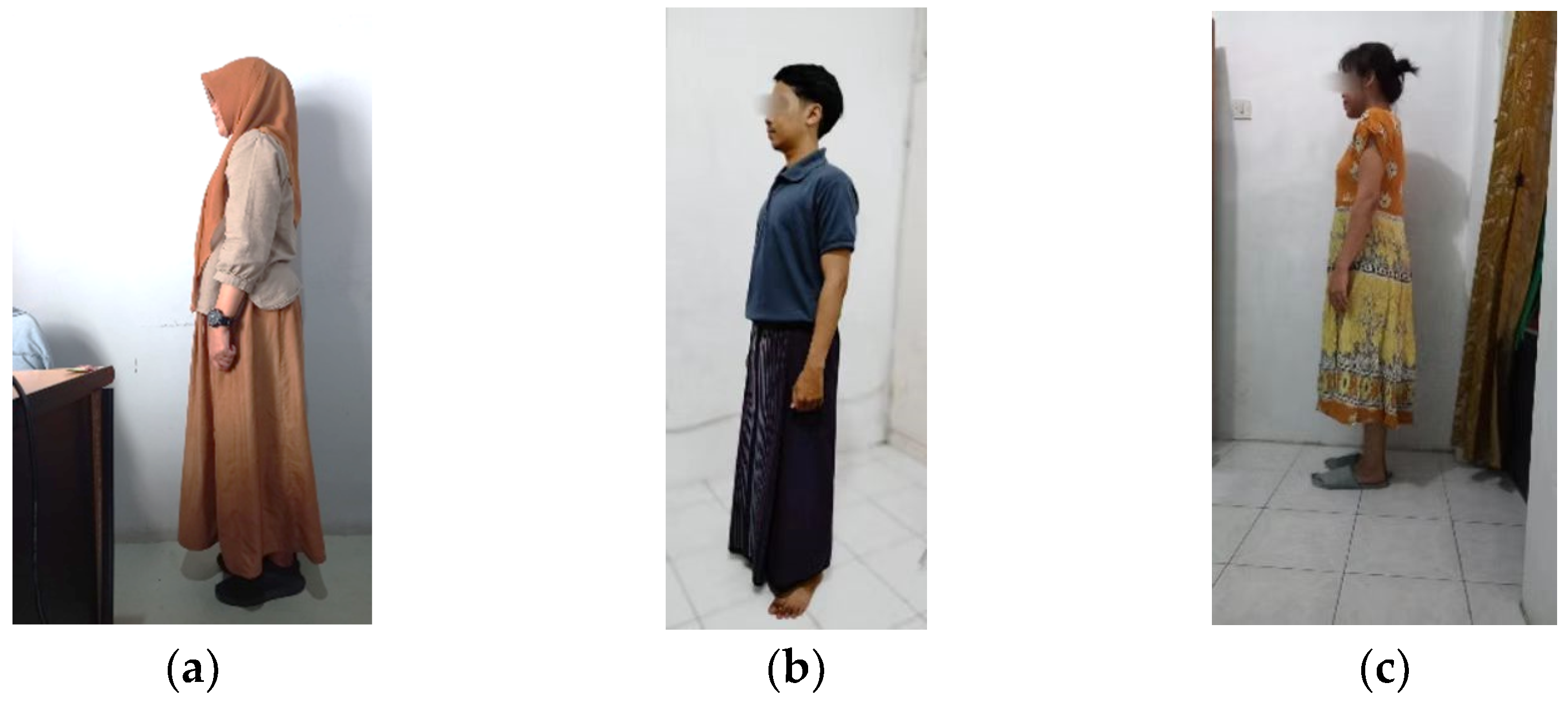
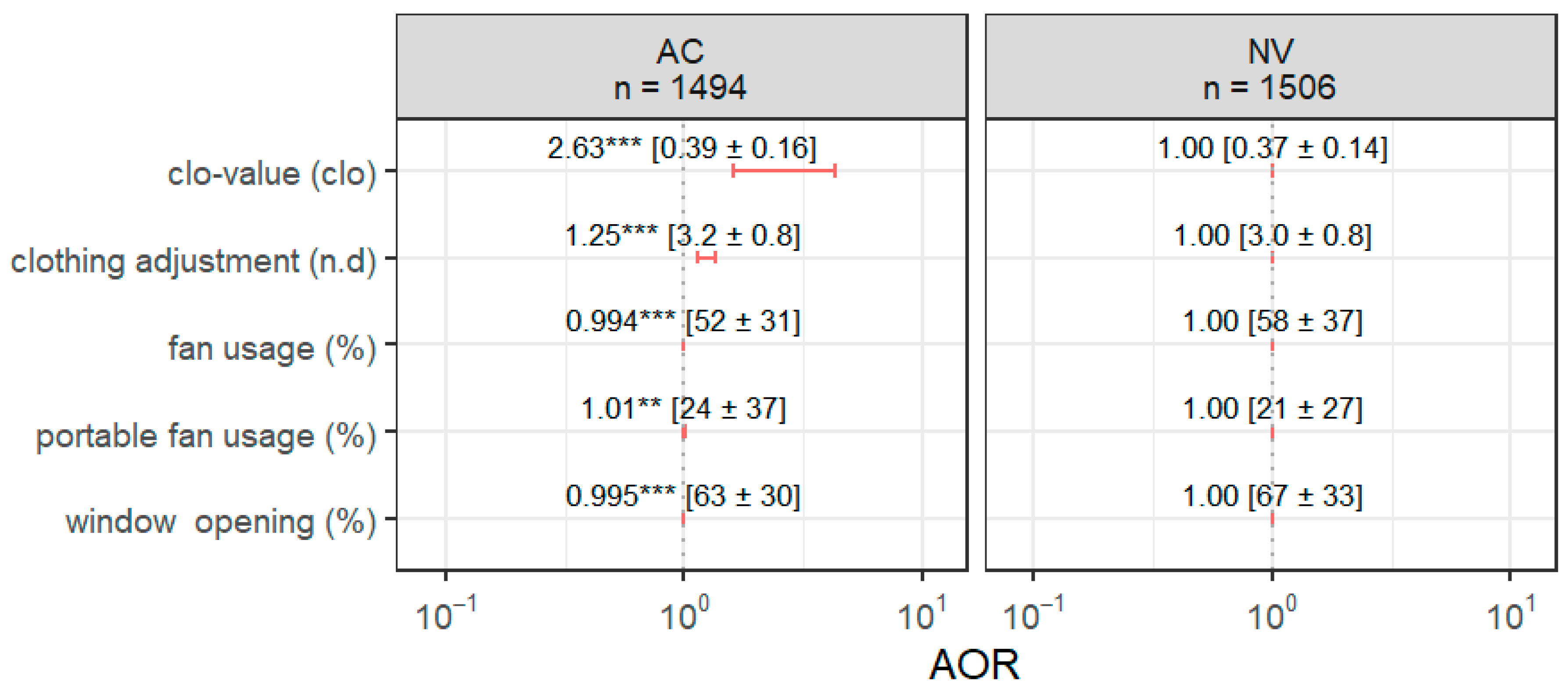
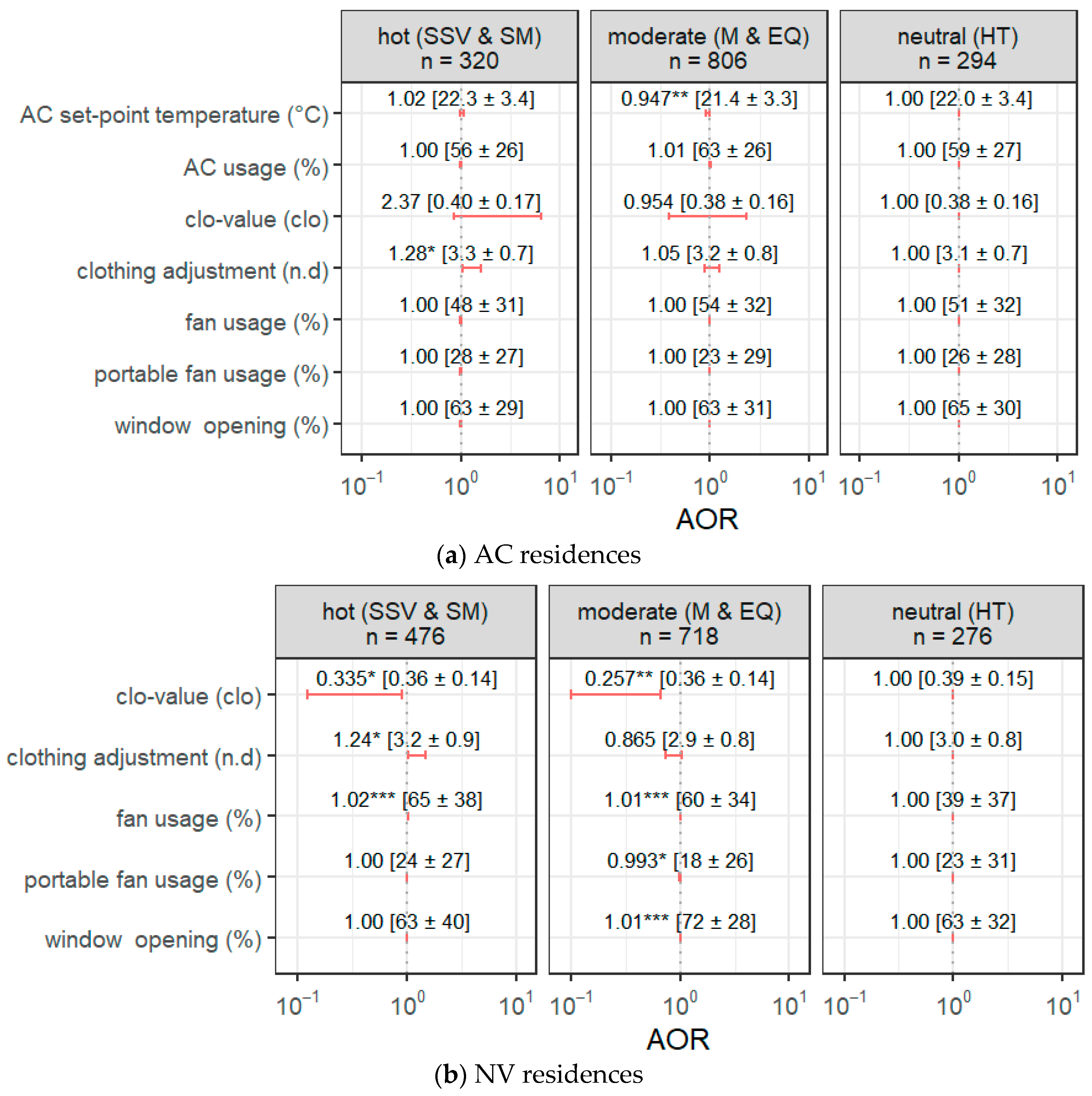
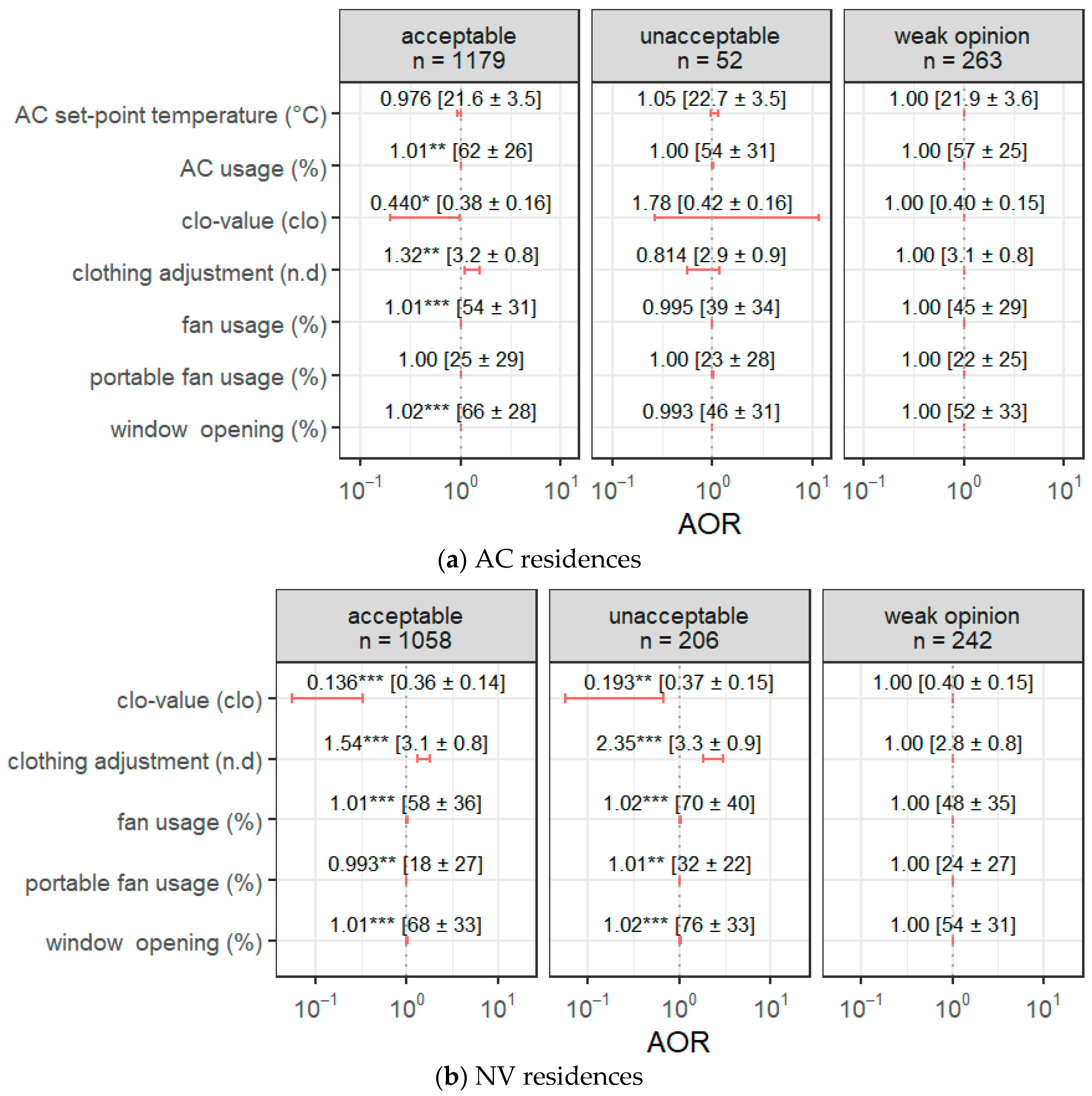
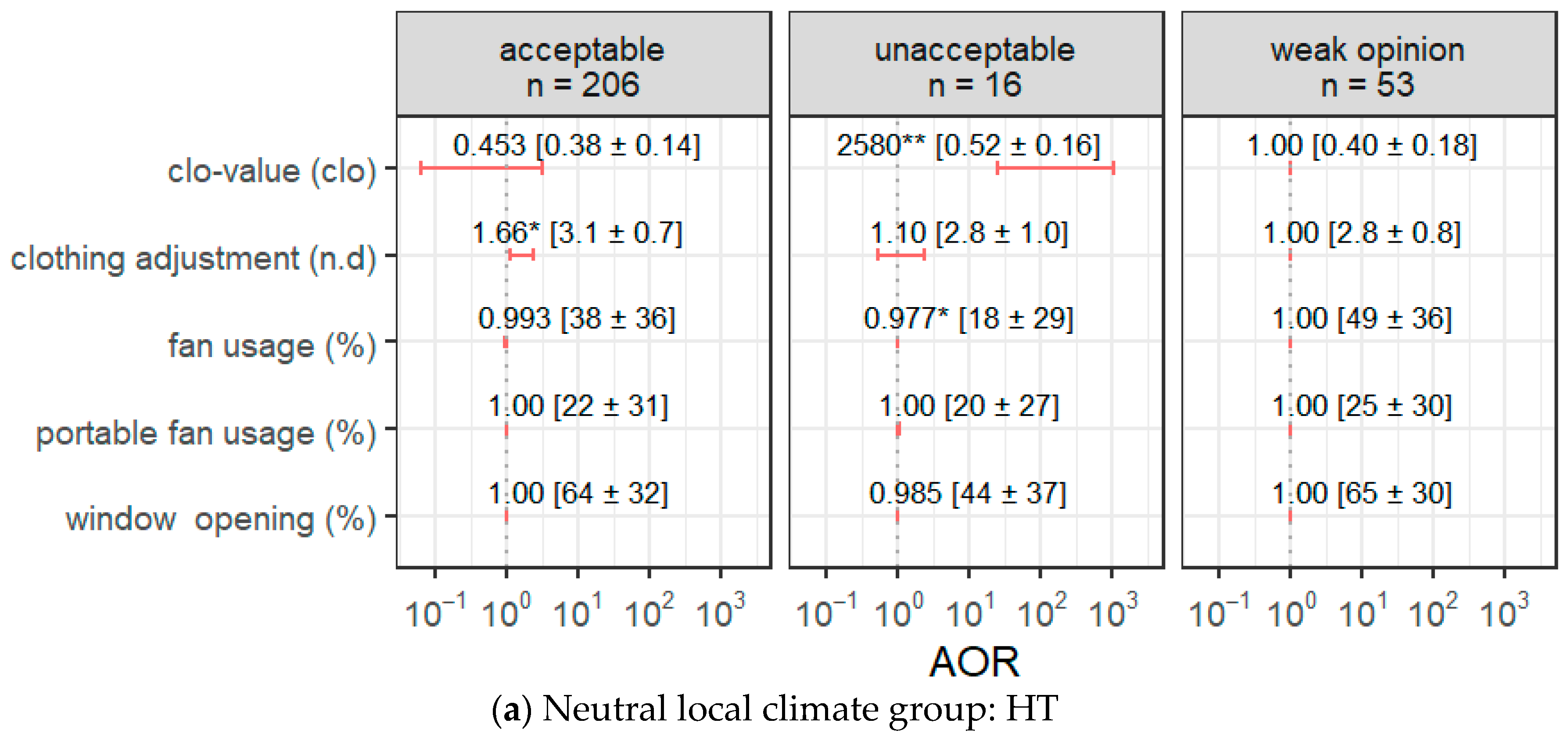
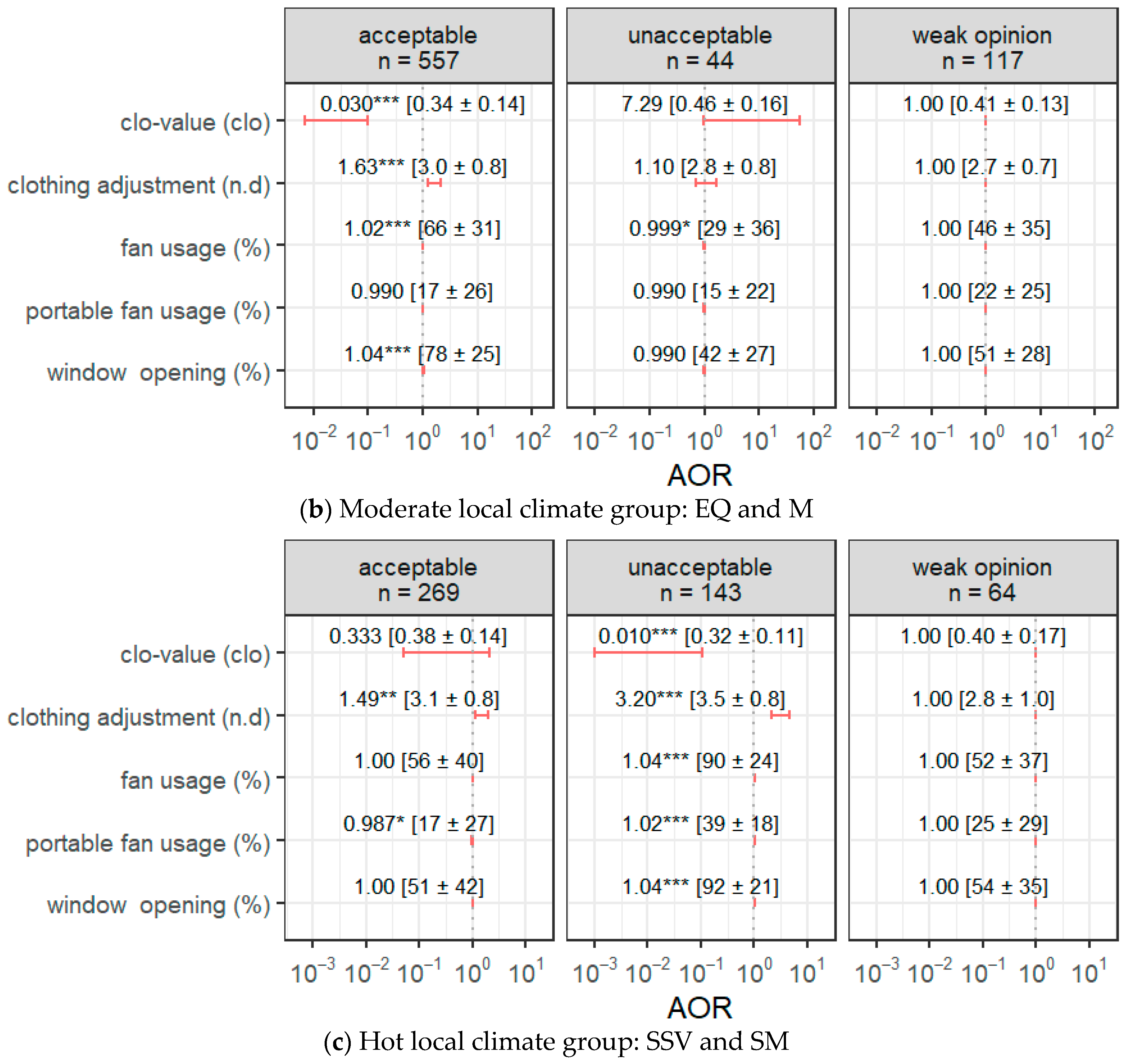
| Local Climate Group | Neutral | Moderate | Hot | |||||
|---|---|---|---|---|---|---|---|---|
| Climate Zone | HT | EQ | M | SEQ | SV | SSV | SM | |
| NV samples (n) | 275 | 352 | 365 | 19 | 15 | 259 | 221 | |
| Samples with an unacceptable thermal environment (n) | 16 | 18 | 26 | 2 | 1 | 70 | 79 | |
| Percentage of unacceptable thermal environment responses (%) | 5.8 | 5.1 | 7.1 | 9.1 | 6.7 | 27.0 | 36.4 | |
| CDDs (°C/year) | 0 | 884.8 | 838.8 | 845.4 | 972.1 | 1374.1 | 1042.7 | |
| AOR of OAB | Clo-value (clo) | 4770 *** | 135 ** | 39.9 ** | - | - | 0.011 ** | 0.0708 * |
| Fan usage intensity (%) | 0.982 | 0.985 * | 0.967 *** | - | - | 1.06 *** | 1.03 *** | |
| Window opening intensity (%) | 0.985 | 0.974 ** | 0.968 *** | - | - | 1.06 *** | 1.03 *** | |
| Portable fan usage intensity (%) | 1.00 | 1.01 | 0.990 | - | - | 1.04 *** | 1.02 *** | |
| Clothing adjustment intensity (categorical) | ** | *** | ||||||
| Never | 0.941 | 0.416 | 5.27 | - | - | 0.00 | 0.498 | |
| Rarely | 1.93 | 0.773 | 6.56 ** | - | - | 0.00 | 1.05 | |
| Sometimes | 0.296 | 0.538 | 1.25 | - | - | 0.0423 *** | 0.586 | |
| Often (reference) | 1.00 | 1.00 | 1.00 | - | - | 1.00 | 1.00 | |
| Variable | Variable Type | Change in −2 Log-Likelihood | Sig. of the Change |
|---|---|---|---|
| Income level | Categorical | 382.66 | 0.000 |
| Workplace | Binary | 206.754 | 0.000 |
| Climate zone | Categorical | 71.056 | 0.000 |
| Type of residence building | Categorical | 25.689 | 0.000 |
| Fan ownership | Binary | 21.193 | 0.000 |
| Variable | Sample Number | AOR (95% Confident Interval) | |
|---|---|---|---|
| BLR-S | BLR-P | ||
| Income | |||
| (1) ≥10 mil. IDR/month | 235 | 11.8 *** (7.34–19.1) | 38.1 *** (17.4–83.7) |
| (2) 5–10 mil. IDR/month | 619 | 5.18 *** (4.17–6.43) | 14.17 *** (7.43–27.0) |
| (3) 3.5–5 mil. IDR/month | 1069 | 0.816 ** (0.701–0.951) | 5.22 *** (2.79–9.76) |
| (4) 2.5–3.5 mil. IDR/month | 591 | 0.440 *** (0.363–0.534) | 2.70 ** (1.43–5.10) |
| (5) 1.5–2.5 mil. IDR/month | 414 | 0.210 *** (0.162–0.272) | 1.10 (0.567–2.12) |
| (6) ≤1.5 mil. IDR/month | 72 | 0.285 *** (0.159–0.514) | 1.00 (1.00–1.00) |
| Workplace | |||
| (1) Factory | 1500 | 0.198 *** (0.169–0.232) | 0.253 *** (0.209–0.307) |
| (2) Office | 1500 | 5.05 *** (4.31–5.92) | 1.00 (1.00–1.00) |
| Climate zone | |||
| (1) Highland tropical climate | 569 | 1.10 (0.912–1.33) | 0.624 ** (0.478–0.815) |
| (2) Sub-savanna climate | 422 | 0.627 *** (0.506–0.778) | 0.330 *** (0.244–0.446) |
| (3) Savanna climate | 25 | 0.759 (0.334–1.72) | 0.519 (0.208–1.29) |
| (4) Sub-equatorial climate | 86 | 3.50 *** (2.06–5.93) | 1.08 (0.596–1.94) |
| (5) Equatorial climate | 692 | 0.915 (0.769–1.09) | 0.798 (0.621–1.03) |
| (6) Sub-monsoonal climate | 374 | 0.739 ** (0.59–0.92) | 0.460 *** (0.340–0.624) |
| (7) Monsoonal climate | 832 | 1.37 *** (1.17–1.62) | 1.00 (1.00–1.00) |
| Building type | |||
| (1) Rusunami | 21 | 19.4 ** (2.59–146) | 12.1 * (1.47–99.9) |
| (2) Rusunawa | 53 | 0.807 (0.462–1.41) | 0.606 (0.316–1.16) |
| (3) Dormitory | 51 | 0.422 ** (0.227–0.783) | 0.276 ** (0.133–0.570) |
| (4) Shophouse | 42 | 1.51 (0.793–2.88) | 1.06 (0.484–2.31) |
| (5) Cluster house | 1148 | 1.29 ** (1.11–1.50) | 1.06 (0.877–1.29) |
| (6) Detached house | 1685 | 0.782 ** (0.675–0.907) | 1.00 (1.00–1.00) |
| Fan ownership | |||
| (1) Do not own fan | 380 | 0.638 *** (0.510–0.799) | 0.529 *** (0.401–0.697) |
| (2) Own fan | 2620 | 1.57 *** (1.25–1.96) | 1.00 (1.00–1.00) |
| OAB | NV Residences | AC Residences | Overall |
|---|---|---|---|
| AC set-point temperature (°C) | - | 21.7 ± 3.5 | - |
| AC usage (%) | - | 60 ± 29 | - |
| Fan usage (%) | 58 ± 37 | 52 ± 31 | 55 ± 34 |
| Window opening (%) | 67 ± 33 | 63 ± 30 | 65 ± 32 |
| Portable fan usage (%) | 21 ± 27 | 24 ± 28 | 23 ± 28 |
| Clothing adjustment (n.d.) | 3.0 ± 0.8 | 3.2 ± 0.8 | 3.1 ± 0.8 |
| Clo-value (clo) | 0.37 ± 0.14 | 0.39 ± 0.16 | 0.38 ± 15 |
| Number of samples | 1506 | 1494 | 3000 |
Disclaimer/Publisher’s Note: The statements, opinions and data contained in all publications are solely those of the individual author(s) and contributor(s) and not of MDPI and/or the editor(s). MDPI and/or the editor(s) disclaim responsibility for any injury to people or property resulting from any ideas, methods, instructions or products referred to in the content. |
© 2024 by the authors. Licensee MDPI, Basel, Switzerland. This article is an open access article distributed under the terms and conditions of the Creative Commons Attribution (CC BY) license (https://creativecommons.org/licenses/by/4.0/).
Share and Cite
Apriliyanthi, S.R.; Sakoi, T.; Kubota, T.; Nakaya, T.; Koerniawan, M.D.; Alfata, M.N.F.; Aziiz, A.D.; Suhedi, F.; Fathuna, I.S.; Takiguchi, T. Relationship Between Occupants’ Adaptive Behaviors, Air-Conditioning Usage, and Thermal Acceptability Among Residences in the Hot–Humid Climate of Indonesia. Buildings 2025, 15, 73. https://doi.org/10.3390/buildings15010073
Apriliyanthi SR, Sakoi T, Kubota T, Nakaya T, Koerniawan MD, Alfata MNF, Aziiz AD, Suhedi F, Fathuna IS, Takiguchi T. Relationship Between Occupants’ Adaptive Behaviors, Air-Conditioning Usage, and Thermal Acceptability Among Residences in the Hot–Humid Climate of Indonesia. Buildings. 2025; 15(1):73. https://doi.org/10.3390/buildings15010073
Chicago/Turabian StyleApriliyanthi, Sri Rahma, Tomonori Sakoi, Tetsu Kubota, Takashi Nakaya, Mochammad Donny Koerniawan, Muhammad Nur Fajri Alfata, Akhlish Diinal Aziiz, Fefen Suhedi, Inat Shani Fathuna, and Taiga Takiguchi. 2025. "Relationship Between Occupants’ Adaptive Behaviors, Air-Conditioning Usage, and Thermal Acceptability Among Residences in the Hot–Humid Climate of Indonesia" Buildings 15, no. 1: 73. https://doi.org/10.3390/buildings15010073
APA StyleApriliyanthi, S. R., Sakoi, T., Kubota, T., Nakaya, T., Koerniawan, M. D., Alfata, M. N. F., Aziiz, A. D., Suhedi, F., Fathuna, I. S., & Takiguchi, T. (2025). Relationship Between Occupants’ Adaptive Behaviors, Air-Conditioning Usage, and Thermal Acceptability Among Residences in the Hot–Humid Climate of Indonesia. Buildings, 15(1), 73. https://doi.org/10.3390/buildings15010073









